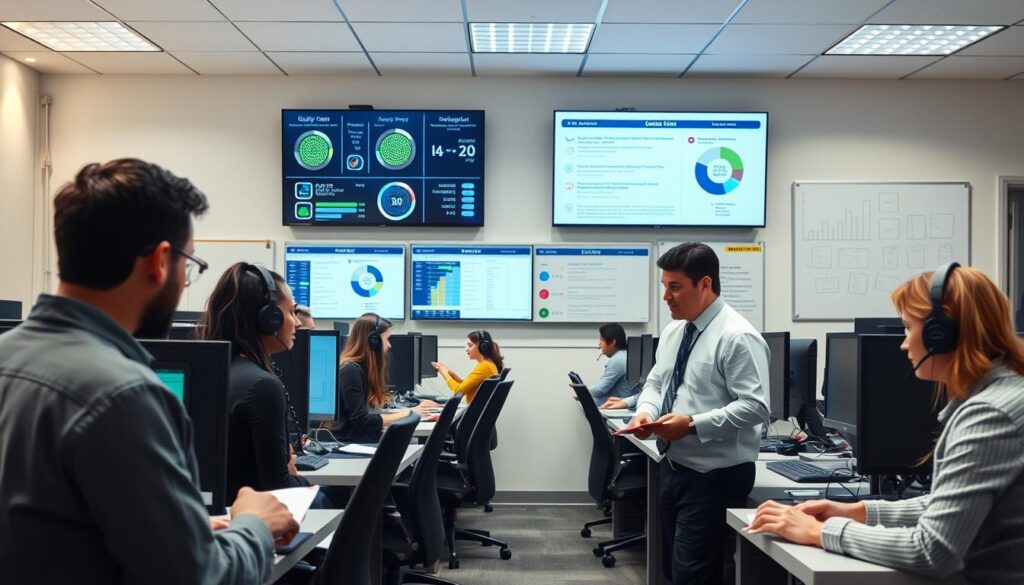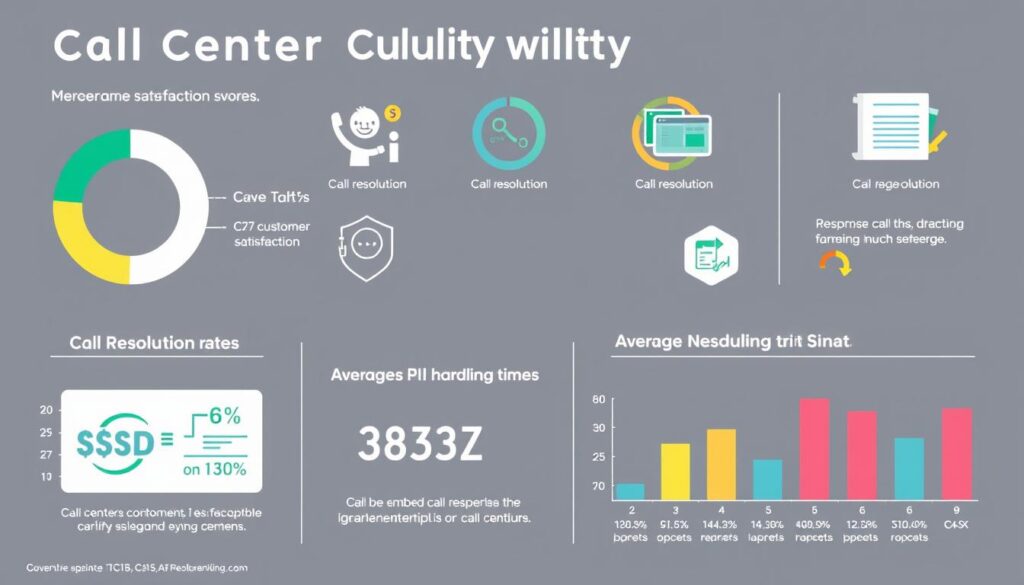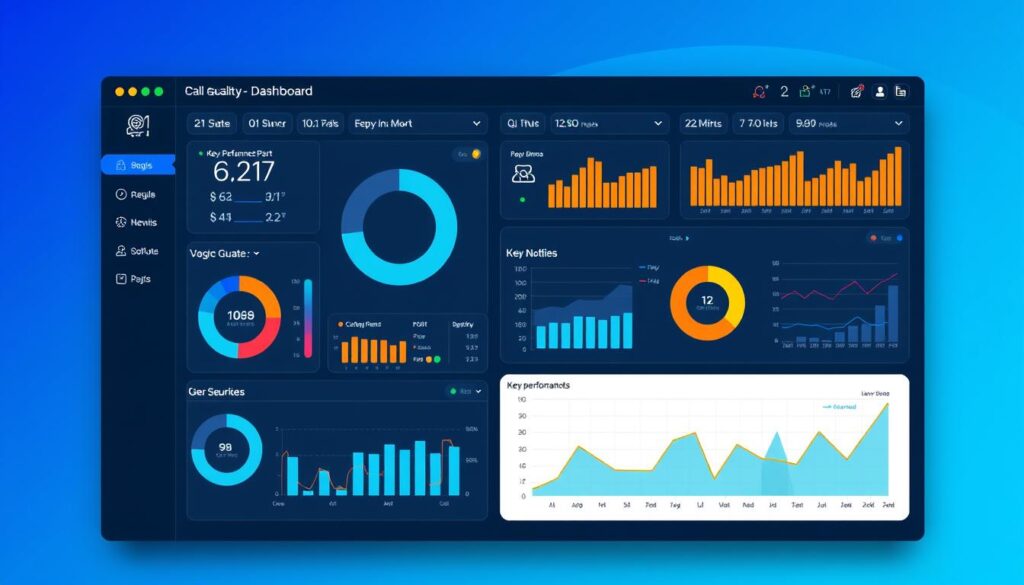Are exceptional customer experiences just a myth in the call center industry, or can they be consistently delivered?
In today’s competitive landscape, customer satisfaction is paramount. Effective quality assurance is crucial for ensuring operational excellence and fostering loyalty. By implementing robust QA processes, businesses can identify areas for improvement in agent performance, enhance customer interactions, and drive business outcomes.
This article will explore the key components of a successful QA program, including monitoring, evaluation, feedback, and coaching, and discuss how these elements contribute to increased customer loyalty and improved operational efficiency.
Understanding Call Center Quality Assurance
Call center quality assurance is a multifaceted process that ensures customer interactions meet predefined quality standards. This comprehensive approach involves evaluating customer service interactions across various criteria to identify areas for improvement.
Definition and Core Components
Call center quality assurance is defined as a systematic process that examines customer interactions to ensure they adhere to established quality benchmarks. The core components of QA include call monitoring, performance evaluation, feedback mechanisms, and continuous improvement processes. These elements work together to assess the effectiveness of customer service agents in fulfilling their responsibilities and meeting customer expectations.

Quality Control vs. Quality Assurance: Key Differences
While often used interchangeably, quality control (QC) and quality assurance (QA) have distinct roles in call centers. QC focuses on the day-to-day operations, such as agent attendance and punctuality, ensuring that the operational efficiency is maintained. On the other hand, QA dives deeper into how calls are handled, including script adherence, call flow, and the use of soft skills. QA is proactive and prevention-focused, directly impacting customer satisfaction, whereas QC is more reactive and detection-oriented.
Why Call Center Quality Assurance Matters
Effective call center quality assurance is crucial for delivering exceptional customer experiences. A solid quality assurance program can be a game-changer, helping to boost customer satisfaction (CSAT), optimize daily operations, and enhance overall contact center performance.

Impact on Customer Satisfaction and Loyalty
Call center quality assurance directly impacts customer satisfaction by ensuring consistent, high-quality service across all interactions. Research has shown that 9.5% of a business’s revenue could be at risk due to poor customer experiences. Conversely, positive experiences make consumers 3.5 times more likely to make repeat purchases. By implementing a robust QA program, businesses can identify and address performance gaps early, preventing small issues from becoming major problems that affect customer loyalty.
Business Benefits of Effective QA Programs
Effective QA programs offer numerous business benefits, including streamlined operations, improved regulatory compliance, reduced customer churn, and enhanced overall contact center performance. By analyzing customer feedback and continuously improving processes, businesses can build stronger customer relationships through consistent service delivery and proactive problem resolution. With 8 out of 10 people believing that customer experience needs improvement, implementing robust QA processes is becoming increasingly important for businesses to stay competitive.
By focusing on quality assurance, call centers can create a foundation for continuous improvement, driving long-term success and customer loyalty. This proactive approach not only enhances customer satisfaction but also contributes to achieving business goals.
The Role of QA Teams in Call Centers
Effective QA teams are the backbone of successful call center operations. They play a crucial role in building better representatives, improving customer experiences, and ensuring that operations run smoothly. QA teams are responsible for designing custom evaluation programs that include scorecards and KPIs to measure how well agents handle interactions across multiple channels.

Key Responsibilities and Functions
QA teams have several key responsibilities, including monitoring agent interactions, assessing communication skills, and evaluating issue resolution. They provide actionable feedback to agents through targeted coaching, which helps improve customer interactions and agent performance. QA professionals also transform raw data into actionable insights through detailed reports that aid leadership in making informed decisions about training, staffing, and workflow improvements.
The key responsibilities of QA teams can be summarized as follows:
| Responsibility | Description |
|---|---|
| Designing Evaluation Programs | Creating custom scorecards and KPIs to measure agent performance across multiple channels. |
| Monitoring Agent Interactions | Assessing how agents communicate, follow scripts, and resolve customer issues. |
| Providing Actionable Feedback | Delivering targeted coaching to agents to improve their skills and customer interactions. |
Skills Required for Effective Quality Analysts
To be effective, quality analysts require a range of skills, including excellent problem-solving and issue resolution abilities, solid analytical skills, and technical comprehension. They must also possess outstanding written and verbal communication skills, exceptional interpersonal skills, and a keen attention to detail. As one expert notes,
“The quality of service provided by call center agents is crucial to the reputation of the business process outsourcing (BPO) company.”
Some of the essential skills for quality analysts include:
- Excellent problem-solving and issue resolution abilities
- Solid analytical skills and technical comprehension
- Outstanding written and verbal communication skills
- Exceptional interpersonal skills and customer care
- Keen attention to detail and thoroughness
By possessing these skills, quality analysts can provide constructive feedback and maintain positive relationships with agents, ultimately enhancing the overall quality of service in call centers.
Building a Comprehensive QA Framework
A well-structured QA framework is essential for call centers to improve their service quality systematically. It serves as a roadmap to better service by analyzing customer interactions and setting clear, measurable quality goals. To build a strong QA strategy, it’s crucial to identify essential KPIs and metrics, decide on an analysis approach, and take action based on insights.

Efficient Framework Models
When crafting a QA framework, consider three proven models that work together to create a comprehensive system. These models help in achieving business goals and enhancing customer satisfaction.
Strategic Framework Model
A strategic framework focuses on team-level metrics such as customer satisfaction (CSAT), Net Promoter Score (NPS), and Customer Effort Score (CES). The goals are defined for teams rather than individuals, and the strategy is reviewed and updated yearly to stay aligned with broader business objectives.
Tactical Framework Model
A tactical framework addresses short-term objectives and everyday processes, identifying recurring issues in scripts, procedures, or tools. This model enables teams to swiftly adapt to obstacles and changes, ensuring consistent quality assurance.
Operational Framework Model
An operational framework is centered on individual agent performance and day-to-day operations. It is individual-centric and feedback-driven, using real-time insights and regular coaching to support agent growth and development. Performance is assessed regularly to catch gaps early and respond with timely action, ultimately enhancing overall performance.
By integrating these framework models and making targets realistic, measurable, time-bound, and shared across the organization, call centers can ensure buy-in and consistency, leading to improved quality and customer satisfaction.
Essential Call Center Quality Assurance Processes
Implementing comprehensive quality assurance processes is essential for call centers to achieve excellence. Call center quality assurance can seem challenging due to the high volume of calls to be assessed, but it is necessary to identify areas of improvement, especially for customer service agents.
QA is an ongoing process for a call center, and representatives should be aware that it is continuous. Recordings should be done regularly for calls, emails, or chats, as these communications determine the quality of customer interactions.

Call Monitoring and Evaluation
Call monitoring is a critical component of QA. It should be implemented consistently across all communication channels to assess the quality of customer interactions. All agents, regardless of performance level, should be monitored and coached, as even top performers can benefit from reinforcement and recognition.
Effective evaluation methods include using standardized scorecards and assessment criteria to ensure consistent quality measurement. As the saying goes, “You can’t improve what you don’t measure.” Consistent monitoring reinforces good habits, improving customer experience and addressing areas for improvement.
Feedback and Coaching Systems
Feedback systems should provide timely, specific, and constructive information to agents about their performance. Coaching systems should translate QA findings into actionable development plans for agents at all performance levels. Recorded communications serve dual purposes: providing coaching opportunities for employees and identifying areas for improvement in operational processes.
As emphasized by industry experts, “This call may be monitored for quality assurance and training purposes.” QA can use recorded communications for coaching and training opportunities, improving customer interactions and operational processes.
Key Performance Indicators for Call Center QA

To ensure high-quality service, call centers must track specific key performance indicators (KPIs) that measure the effectiveness of their quality assurance programs. These KPIs provide insights into various aspects of call center operations, including customer satisfaction, agent performance, and operational efficiency.
Customer-Focused Metrics
Customer-focused metrics are essential for understanding how well a call center meets customer expectations. Key metrics include Customer Satisfaction (CSAT) ratings, Net Promoter Score (NPS), and Customer Effort Score (CES). These metrics help call centers understand customer perceptions and identify areas for improvement. First-call resolution rates are also critical, as they directly impact customer satisfaction and loyalty.
Operational and Agent Performance Metrics
Operational metrics such as average handling time and response time provide insights into call center efficiency. Agent performance metrics, including adherence to scripts, problem-solving abilities, and communication skills, are assessed during QA evaluations. These metrics fall into different evaluation categories, offering a comprehensive view of strengths and weaknesses in service delivery. Regular tracking of these metrics builds accountability and supports continuous improvement across the support team.
Effective QA programs use a balanced scorecard approach that considers both quantitative metrics and qualitative assessments of customer interactions. By leveraging these KPIs, call centers can enhance customer satisfaction, improve agent performance, and maintain high-quality service standards.
6 Call Center Quality Assurance Best Practices
Effective quality assurance in call centers involves a range of processes and methodologies. To achieve operational excellence, organizations must adopt a combination of strategies that enhance customer satisfaction, improve agent performance, and drive business results.
1. Implement Regular Coaching and Mentoring
Regular coaching and mentoring help agents develop their skills, with personalized sessions based on QA findings that address individual strengths and weaknesses. Use quality assurance findings to personalize coaching sessions, boosting morale and service quality.
2. Establish Systematic Call Monitoring
Systematic call monitoring processes catch mistakes early and provide targeted feedback to agents. Consider using AI-powered voice analytics to identify coaching opportunities faster.
3. Develop Comprehensive Scorecards and KPIs
A mix of metrics like CSAT, AHT, and FCR provides a 360-degree view of agent performance. Regularly calibrate KPIs to meet evolving customer expectations and business needs.
| Metric | Description | Benefit |
|---|---|---|
| CSAT | Customer Satisfaction Score | Measures customer satisfaction |
| AHT | Average Handling Time | Optimizes agent productivity |
| FCR | First Call Resolution | Enhances customer experience |
4. Analyze Customer Feedback Effectively
Run post-call surveys to gather direct feedback from customers. Act quickly on negative feedback to turn poor experiences into loyal partnerships.

5. Integrate Technology Solutions
Tools like sentiment analysis and automated QA platforms improve efficiency while maintaining the human element in quality assessment. Pair automation with human QA to balance speed with emotional intelligence.
6. Maintain Adaptability and Flexibility
Be ready to adjust QA strategies in response to changing trends and customer behavior. Establish quarterly QA reviews to stay aligned with company goals and customer needs.
How to Standardize Call Monitoring for Consistent Results
Standardizing call monitoring is crucial for developing high-performing call center agents and ensuring consistent quality assessment. An inconsistent call monitoring process can lead to confusion among team leaders and make it challenging to provide clear guidance for improvement.

To achieve consistency, it’s essential to create standardized evaluation criteria that clearly define what constitutes quality in different types of customer interactions. This involves developing a comprehensive framework that assesses various aspects of call handling, such as communication skills, problem-solving, and adherence to company policies.
Creating Standardized Evaluation Criteria
Standardized evaluation criteria ensure that all calls are assessed based on the same standards, enabling fair and unbiased evaluations. To create these criteria, organizations should involve various stakeholders, including quality assurance specialists, team leaders, and agents. This collaborative approach helps to identify key performance indicators that are relevant to the organization’s goals and objectives.
Ensuring Evaluator Calibration
Evaluator calibration is critical to ensure that all QA specialists and team leaders are applying the same standards when assessing agent performance. Regular training sessions and calibration exercises can help to achieve this goal. By ensuring that evaluators are calibrated, organizations can maintain consistency in their call monitoring processes and make informed decisions about agent development and performance improvement.
To further enhance the call monitoring process, organizations can leverage technology solutions, such as quality management software, to automate scoring, analytics, and benchmarking. This not only streamlines the process but also provides valuable insights into agent performance and areas for improvement.
Tools and Technology for Call Center QA

The role of technology in call center quality assurance cannot be overstated. With the advancement in tools and technologies, call centers can now enhance their QA processes significantly.
AI-Powered QA Solutions
AI-powered QA solutions are revolutionizing the way call centers approach quality assurance. These solutions can analyze 100% of customer interactions, providing comprehensive insights into agent performance. Unlike traditional methods that rely on sampling, AI-powered solutions offer a more accurate and unbiased assessment.
By leveraging natural language processing technologies, these solutions can detect sentiment, effort, and emotion in customer interactions. This enables call centers to identify trends and opportunities for improvement across every interaction.
Analytics and Reporting Platforms
Analytics and reporting platforms play a crucial role in call center QA. Tools like SafetyCulture (iAuditor) offer scoring and analytics capabilities that help QA specialists gauge call quality, monitor trends, and identify training opportunities.
With cloud-based storage, these platforms securely store data, enabling QA specialists to develop action plans aligned with business goals. Standardized QA forms and scorecards can be implemented across the organization to ensure consistent evaluation criteria.
While technology enhances efficiency, the human element remains crucial for interpreting data and providing context-sensitive coaching to agents. By combining the right tools with skilled QA specialists, call centers can achieve significant improvements in quality assurance.
Improving Agent Performance Through QA
Agent performance can be significantly enhanced through robust QA processes. By implementing a comprehensive quality assurance program, call centers can identify areas where agents need improvement and provide targeted coaching to help them grow.
Identifying Coaching Opportunities
One of the primary ways QA improves agent performance is by identifying coaching opportunities. Through call monitoring and evaluation, QA specialists can pinpoint specific areas where agents are struggling and develop targeted coaching plans to address these gaps. This might involve recognizing patterns in customer interactions or identifying performance gaps against established standards.
For instance, a QA evaluation might reveal that an agent consistently struggles with resolving complex customer complaints. In this case, a targeted coaching plan could be developed to provide the agent with additional training on conflict resolution and negotiation skills.
Creating Personalized Development Plans
Creating personalized development plans is crucial for improving agent performance. Rather than applying a one-size-fits-all approach, QA specialists can work with agents to develop tailored plans that address their unique needs and strengths.
A personalized development plan might include specific goals and objectives, such as improving first-call resolution rates or reducing average handling time. By providing agents with clear targets and ongoing support, QA specialists can help them stay motivated and focused on delivering exceptional customer service.
| Coaching Method | Description | Benefits |
|---|---|---|
| Targeted Coaching | QA specialists work with agents to address specific areas for improvement | Improved agent performance, increased customer satisfaction |
| Personalized Development Plans | Agents receive tailored plans that address their unique needs and strengths | Increased agent engagement, improved performance |
| Gamification and Incentives | Agents are rewarded for achieving specific targets or milestones | Increased motivation, improved performance |
By leveraging QA findings to inform coaching and development initiatives, call centers can create a culture of continuous improvement that drives agent performance and customer satisfaction.
Overcoming Common Call Center QA Challenges
The dynamic nature of call center operations presents several QA challenges that must be addressed to ensure high-quality customer interactions. Call centers are constantly adapting to new customer needs, technologies, and market conditions, making it difficult to maintain consistent quality standards.
Balancing Quantity and Quality
One of the primary challenges in call center QA is balancing the quantity of calls with the quality of customer interactions. Agents are often expected to handle a high volume of calls while maintaining a high level of customer satisfaction. This can be achieved by implementing efficient call handling processes and providing agents with the training and tools they need to resolve customer issues effectively.
| Challenge | Solution |
|---|---|
| High call volume | Efficient call routing and handling processes |
| Maintaining quality | Regular training and feedback for agents |
Managing Agent Resistance to Monitoring
Another significant challenge is managing agent resistance to monitoring. Agents may feel that monitoring is punitive rather than constructive. To overcome this, it’s essential to create a positive culture around QA that emphasizes development and improvement rather than criticism.
By understanding these challenges and implementing practical solutions, call centers can improve their QA processes, enhance customer satisfaction, and increase operational efficiency.
Measuring the ROI of Your QA Program
Understanding the return on investment (ROI) of your call center’s quality assurance (QA) program is crucial for justifying resources and securing ongoing support. Effective QA programs can significantly impact both direct financial benefits and indirect value creation for your business.
Direct Financial Benefits
Effective QA programs can lead to reduced customer churn, increased repeat purchases, and lower operational costs through improved efficiency. According to our 2022 Consumer Trends Report, positive customer interactions make consumers 3.5x more likely to purchase again. By improving first-call resolution rates and reducing average handling time, businesses can directly impact their bottom line. For instance, a well-implemented QA program can help identify areas for improvement, leading to cost savings and enhanced customer satisfaction.
Indirect Value Creation
Beyond direct financial benefits, QA programs contribute to enhanced brand reputation, increased customer loyalty, and improved word-of-mouth marketing. Data from QA evaluations can be used to identify trends and inform strategic business decisions that drive long-term growth. By leveraging these insights, businesses can create a positive feedback loop that continually improves customer interactions and overall business performance.
Conclusion: Building a Culture of Continuous Improvement
As we conclude our exploration of call center quality assurance, it’s clear that a well-implemented QA program is crucial for delivering exceptional customer experiences. By implementing a comprehensive QA framework, call centers can foster a culture of continuous improvement that enhances not only individual agent performance but also the overall organization.
Successful call centers combine motivated and skilled teams, advanced technology, and the right QA strategy to exceed customer expectations. It’s essential to view QA not as a mere box-ticking exercise but as a strategic management tool that drives organizational excellence. By using standardized processes, appropriate metrics, and regular coaching, call centers can maintain consistent quality across all customer interactions.
To improve your call center operations, consider implementing the quality assurance frameworks and best practices discussed in this article. As customer expectations and technologies continue to evolve, it’s crucial to stay ahead of the curve and adapt your QA practices accordingly. By doing so, you can ensure that your call center remains a cornerstone of exceptional customer service, driving long-term success and customer loyalty.


